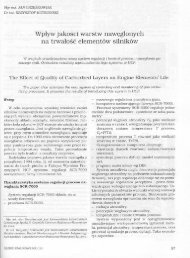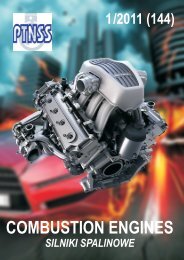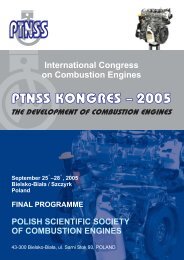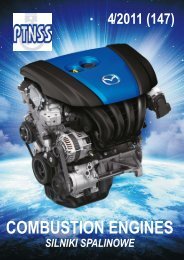Create successful ePaper yourself
Turn your PDF publications into a flip-book with our unique Google optimized e-Paper software.
The use of multi-equation models in the analysis of dynamic processes...<br />
x 1<br />
– engine speed n [rpm]; x 2<br />
– engine torque T tq<br />
[N·m];<br />
x 3<br />
– coking of the spray nozzle S k<br />
[µm 2 ].<br />
Similar treatment was applied to the Y of the output<br />
quantities, limiting the number of its elements to only the<br />
primary exhaust components in the exhaust manifold: y 1<br />
–<br />
concentration of carbon monoxide in the exhaust manifold<br />
C CO(k)<br />
[ppm]; y 2<br />
– concentration of hydrocarbons in the<br />
exhaust manifold C HC(k)<br />
[ppm]; y 3<br />
– concentration of nitric<br />
oxides in the exhaust manifold C NOx(k)<br />
[ppm]. Changes of the<br />
input and output quantities during the dynamic process have<br />
been shown in Fig. 1.<br />
Statistical identification was made using GRETL [2].<br />
Estimation of the equation coefficients for specific output<br />
variables was performed using the least-squares method and<br />
it had to verify the significance of its parameters and, consequently,<br />
the rejection of insignificant values, which consequently<br />
led to a significant simplification of the models. The<br />
significance values of model parameters have been shown in<br />
a graphical manner (Table 1, 2, 3). The equations describing<br />
the changes in the concentration of hydrocarbons (y 2<br />
) and<br />
nitric oxides (y 3<br />
) have undergone the greatest simplification.<br />
(Table 2, 3). In the case of the equation describing the change<br />
of the content of hydrocarbons they heavily depend on the<br />
structure parameter, which represents coking of the spray<br />
nozzle (x 3<br />
). The case of a model describing the changes in<br />
the carbon monoxide content (y 1<br />
) is similar.<br />
An even distribution of residuals from the regression of<br />
mean values may be indicative of being a good fit model to<br />
the values obtained from the experiment on the engine.<br />
4. Summary<br />
The presented description of the active experiment space<br />
by the multidimensional models gives great possibilities in<br />
the analysis of the measurement data and scientific reasoning.<br />
Furthermore, assuming that the matrix of the coefficients<br />
(C o )T is orthogonal, there is a possibility of fulfilling a reverse<br />
task, i.e. estimating with complex relevance and known<br />
input variables describing the work points (engine speed<br />
n and torque load T tq<br />
and other input quantities. In further<br />
works the authors will attempt to investigate this issue.<br />
Paper reviewed/Artykuł recenzowany<br />
4. Podsumowanie<br />
Przedstawiony opis przestrzeni eksperymentu czynnego<br />
za pomocą modeli wielowymiarowych daje wielkie możliwości<br />
w analizie danych pomiarowych i wnioskowaniu<br />
naukowym. Ponadto istnieje możliwość, przy założeniu<br />
ortogonalności macierzy współczynników (C o ) T , wykonania<br />
zadania odwrotnego, czyli szacowania, z założoną istotnością,<br />
przy znanych zmiennych wejściowych opisujących<br />
punkt pracy, tj.: prędkości obrotowej silnika n i obciążenia<br />
momentem obrotowym T tq<br />
, pozostałych wielkości wejściowych.<br />
Bibliography/Literatura<br />
[1] Kośko M., Osińska M., Stępińska J.: Ekonometria współczesna.<br />
TONiK, Toruń 2007.<br />
[2] Kufel T.: Ekonometria. Rozwiązywanie problemów z wykorzystywaniem<br />
programu GRETL. Wydawnictwo Naukowe<br />
PWN, Warszawa 2007.<br />
[3] Kukiełka L.: Podstawy badań inżynierskich. Wydawnictwo<br />
Naukowe PW, Warszawa 2002.<br />
[4] Piaseczny L., Zadrąg R.: The influence of selected damages<br />
of engine zs type on the changes of emission of exhaust gas<br />
components. Silniki Spalinowe, Opole 2009.<br />
[5] Polański Z.: Planowanie doświadczeń w technice. PWN,<br />
Warszawa 1984.<br />
[6] Robertson J., Robertson S.: Pełna analiza systemowa. WNT,<br />
Warszawa 1999.<br />
[7] Zadrąg R.: Kryteria doboru parametru diagnostycznego na<br />
potrzeby diagnostyki okrętowego silnika spalinowego, Logistyka<br />
nr 4/2010, Poznań 2010.<br />
[8] Zadrąg R.: Modele wielorównaniowe szczelności układu wymiany<br />
ładunku silnika okrętowego. Silniki gazowe – wybrane<br />
zagadnienia, pod red. A. Dużyńskiego, seria Monografie nr<br />
183. Wydawnictwo Politechniki Częstochowskiej, Częstochowa<br />
2010.<br />
[9] Zadrąg R.: The multi-equational models in the analysis of<br />
results of marine diesel engines research. Międzynarodowa<br />
konferencja Eksplodiesel& Gas Turbine’2009. Międzyzdroje-<br />
Kopenhaga 2009.<br />
[10] Zadrąg R. i in.: Modele identyfikacji stanu technicznego silnika<br />
na podstawie oceny emisji składników spalin. Sprawozdanie<br />
z projektu badawczego nr 4T12D 055 29. AMW, Gdynia<br />
2008.<br />
[11] Zadrąg R., Zellma M.: Analiza wyników badań silników<br />
spalinowych przy wykorzystaniu modeli wielowymiarowych.<br />
Sympozjum Siłowni Okrętowych Symso’2009, Gdynia<br />
2009.<br />
Ryszard Zadrąg, DEng. – doctor in the Faculty of<br />
Mechanical and Electrical Engineering at Polish<br />
Naval Academy of Gdynia.<br />
Dr inż. Ryszard Zadrąg – st. wykładowca na Wydziale<br />
Mechaniczno-Elektrycznym Akademii Marynarki<br />
wojennej w Gdyni.<br />
e-mail: r.zadrag@amw.gdynia.pl<br />
Marek Zellma, DEng. – doctor in the Faculty of Mechanical<br />
and Electrical Engineering at Polish Naval<br />
Academy of Gdynia.<br />
Dr inż. Marek Zellma – st. wykładowca na Wydziale<br />
Mechaniczno-Elektrycznym Akademii Marynarki<br />
Wojennej w Gdyni.<br />
e-mail: m.zellma@amw.gdynia.pl<br />
<strong>COMBUSTION</strong> <strong>ENGINES</strong>, No. 4/2012 (151)<br />
85












